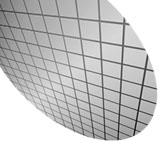

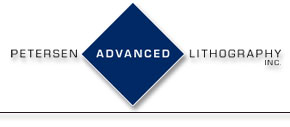
 |
 |
 |
 |
 |
 |
 |
Sidewall Chrome Alternating Aperture—SCAA Mask
The SCAA test mask allows you to evaluate subwavelength imaging, perform resist profiling and evaluate phase-shift technology with minimal pitch-dependent phase error. At 248, it offers 100 nm imaging down to 200 nm pitch. A 193 mask is being built (spring 2002), and custom masks can be designed to meet unique specifications. The SCAA test mask provides resolution to a k1 of 0.25.
SCAA Mask Concept
Introduced by Marc Levenson in 1992, Sidewall Chrome Alternating Aperture (SCAA) Mask uses a pre-patterned phase-shift reticle that is recoated with chrome and resist, then written a second time to produce a mask that offers superior imaging performance and resistance to phase and amplitude errors due to fabrication and electromagnetic effects. The SEM image below shows an example SCAA mask (photo courtesy Marc D. Levenson).

After extensive analysis and testing of SCAA Mask in simulation, PAL has adapted the technology into an effective tool for evaluating subwavelength imaging.
SCAA Mask Fabrication
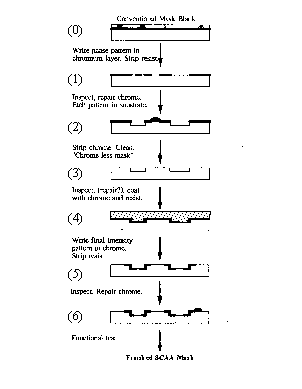 As
shown right, a SCAA mask is manufactured by taking a chromeless mask with
an appropriate phase pattern, re-coating it with chrome and resist, and
writing the desired exposure pattern in the chrome layer. The result is
a phase-shift mask structure where all quartz walls are covered by opaque
chrome and all chrome is supported by quartz.
As
shown right, a SCAA mask is manufactured by taking a chromeless mask with
an appropriate phase pattern, re-coating it with chrome and resist, and
writing the desired exposure pattern in the chrome layer. The result is
a phase-shift mask structure where all quartz walls are covered by opaque
chrome and all chrome is supported by quartz.
With all glass sidewalls covered and all chrome supported, the SCAA mask
is largely immune to the phase and amplitude anomalies that cause space-width
alternations as well as the design, fabrication, and cleaning difficulties
that plague other PSM structures.
Advantages
Over Other Types of Phase-Shift Masks
Compared to other types of phase-shift structures, SCAA mask offers improved
imaging performance because the immediate environments of the transparent
apertures are the same for 0° and 180° spaces. The amplitudes
of the spaces are controlled only by the sizes of the apertures in the
chrome layer, not by surfaces or trenches above. This symmetry between
0° and 180° spaces on a SCAA mask eliminates the need to alter
the mask design to compensate for non-ideal amplitudes and phases. No
need to correct for different transmission factors by biasing 0° and
180° spaces differently, or to accommodate non-geometrical phase shifts
that depend on trench width, sidewall angle and wall quality. As an example,
the image below shows how SCAA E-fields are not sensitive to sidewall
angle whereas an asymmetric bias altPSMs are sensitive.
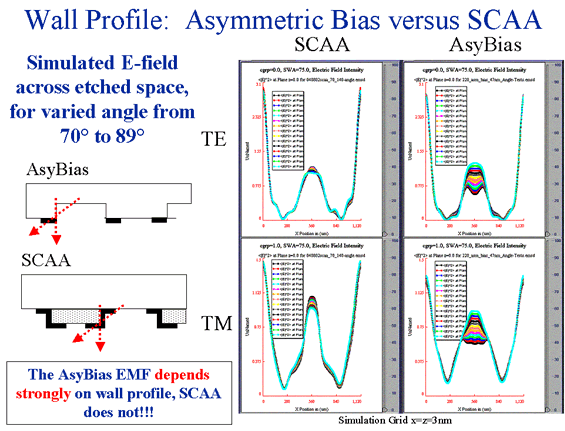
SCAA vs. asymmetric bias comparison
The table below summarizes the comparison of important litho process and manufacturing criteria for SCAA and asymmetric biased masks.

Again, other designs shown below require detailed mask engineering and OPC even after biasing the space widths.
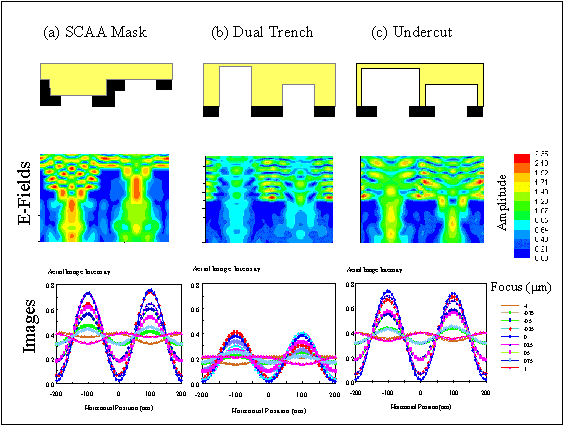
SCAA Test Mask Modules
The SCAA mask provides the following test modules:
- "QCLEAVE" Cross-sectional SEM lines down to 140nm pitch for 193nm lithography and 160nm for 248nm.
- Dark-field gate structures with bright-field trim for dual exposure processing. This module can be used to explore aperture size, gate biasing, gate pitch, and trim mask bias.
- Scatterometry targets: Minimized pitch dependent phase-error means minimal line walking through focus.
- Phase analysis of box-in-box structures for easy metrology. This module can be used to monitor mask phase effects or lens aberrations.
These modules are useful for:
- Resist evaluations
- Building scatterometry structures
- Phase retrieval modules
- 70nm technology node and below
To read about SCAA Mask performance in simulation studies, read our 2001 SPIE paper or examine the data we collected.
SCAA
Mask is available through a collaborative project with  and
and ![]()
Back to Products
|
© 2003 Petersen Advanced Lithography, Inc. |